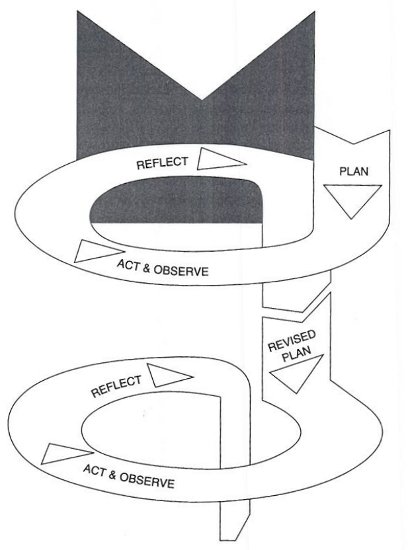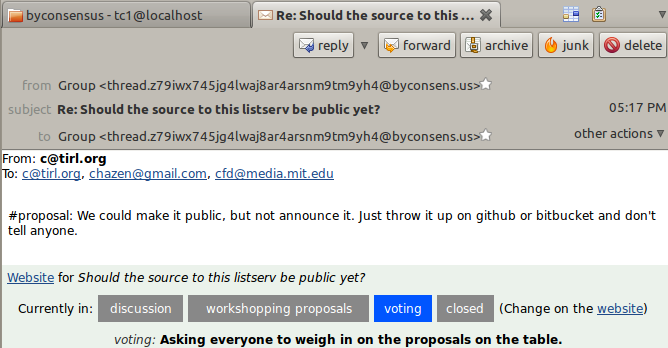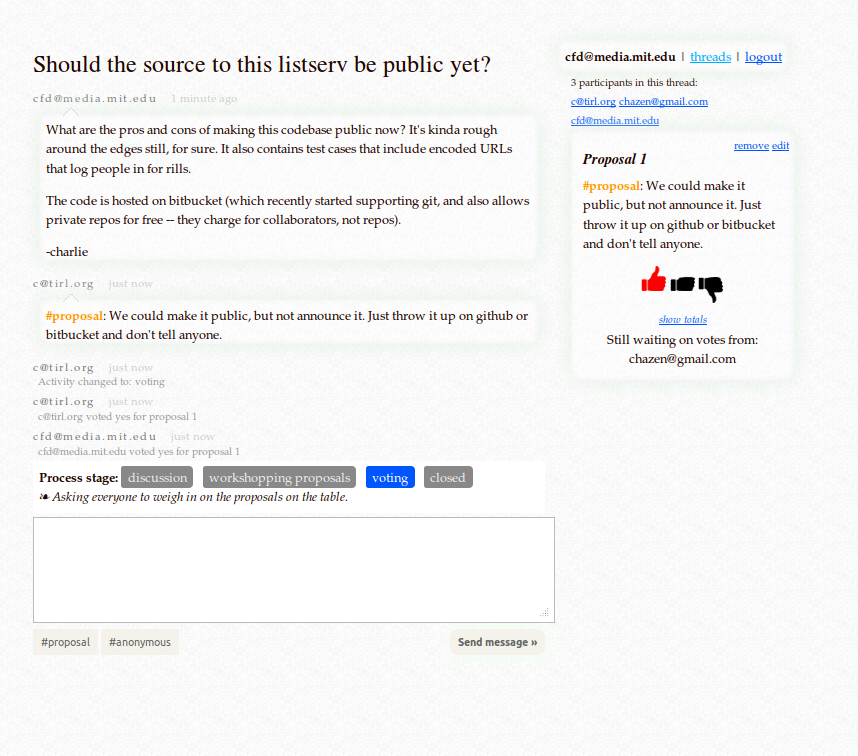Tools for Consensus
My background
12 years practicing consensus
- Housing co-ops
- Workers collectives
- Boards of directors
- Groups ranging from 3 to 50 people
Participatory Democracy
Stakeholders have the ability to participate
in decisions
that affect them.
the freedom to call something into being which did not exist before, which was not given… and which therefore, strictly speaking, could not be known.Hannah Arendt
Challenges of consensus
- It's inefficient
Occupy Wall St held 3-4 hour GA every day - Selects for stubborn, idle, eloquent
- It's limited to small groups (usually less than 100)
- It takes time to learn
- “Style” objections
Big audacious question
Can we use technology to increase democratic participation (in all aspects of life)?
Research Context
- Group Decision Support Systems
- Structuration theory
- Participatory Democracy
Qualitative Methods
| “Neutral” domains | “Political” domains |
|---|---|
|
|
Marshall and Rossman, 1995
Participatory Action Research
- is a social process
- is participatory
- is practical and collaborative
- is emancipatory
- is critical
- is recursive (reflective, dialectical)
Knowledge domain
| Interest | Knowledge | Medium | Science |
|---|---|---|---|
| Technical | Instrumental (causal explanation) | Work | Empirical-analytic or natural sciences |
| Practical | Practical (understanding) | Language | Interpretive, descriptive |
| Emancipatory | Emancipatory (reflection) | Power | Critical sciences |
Carr, Kemmis. "Becoming Critical", p 136
Process

Kemis, McTaggart. "Participatory Action Research: Communicative Action and the Public Sphere", p 564
Participants
- People living in cooperative houses
- Bi-national non-profit board of directors
- Activist groups
Process
Designs
First exploration: Email augmentation


Findings
- Despite being email, it's still confusing.
- Interface not self-documenting enough; or participants not adequately trained.
- Insufficient hinting for flow of decision-making process.
- “Too much email.” (stressful)
- “Too impersonal.” (Low conveyance of emotion)
Phase 2: Get serious
- Education. Democracy depends on user acceptance.
- Different tools for different task types
- Participatory design process
Tools currently in development and testing
| Tool | Task | Group type | Innovation |
|---|---|---|---|
| Dotstorm | Generating ideas (NGT) | 5 to 50 people, synchronous, global | Record history of brainstorm, share brainstorm embedded in blogs/websites, works across geographies |
| Flame War | Education: decisions over email | 4-6 people, local (card game) | Playing with challenges of email decision making in a game environment |
| Education: decisions with constrained channel | 8-20 people, local (workshop) | Playing with challenges of decision making in constrained communication channels | |
| Negotiation: find shared principles/values | 10-50 people, synchronous, global | Remake of MayFirst/People Link's "Meetings" tool with improved accessibility, user interface | |
| Progressive Timekeeper | Negotiation: tracking speaking time | Any number of people, synchronous, local | Tool for tracking speaking time by configurable identity category. Allows groups to reflect on how identity category might impact meeting participation. |
| Minutes recording tool (Mockup) | Process: recording minutes | 10-100 people, synchronous and asynchronous, global | Record minutes in a more consistent manner, more easily, with better tracking of outcomes, more nuanced channels/signals, and continued discussion online. |